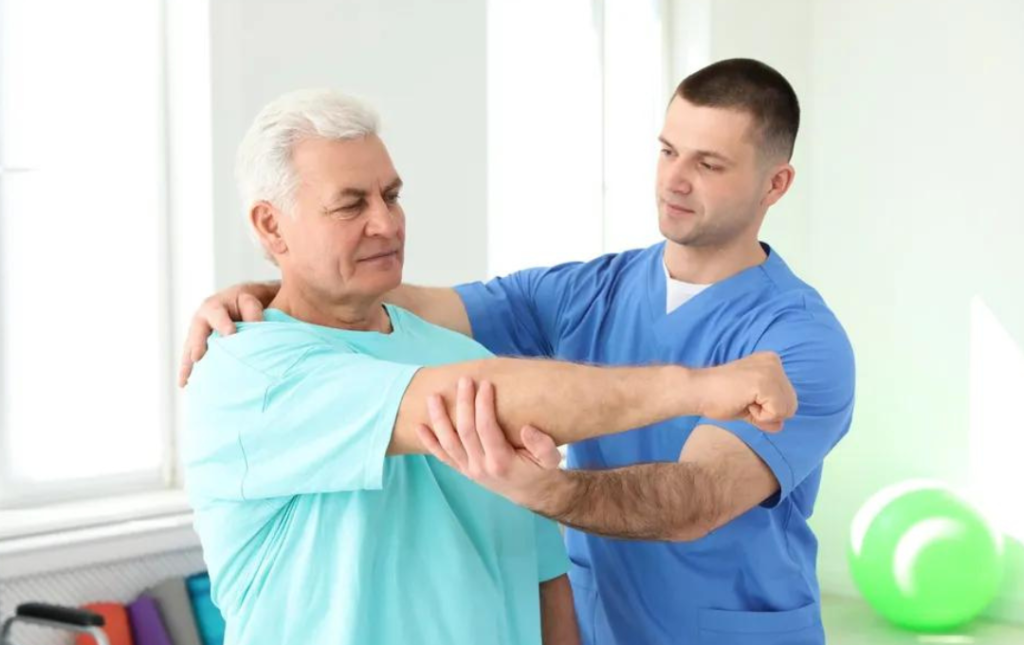In the realm of stroke rehabilitation, where recovery is both a science and an art, Sukino Healthcare stands as a beacon of innovation and hope. Stroke, a condition that can lead to profound physical and neurological challenges, requires a multidimensional approach to rehabilitation. Sukino Healthcare, a pioneer in the field of rehabilitation, embraces cutting-edge techniques in stroke rehabilitation physiotherapy. In this blog, we explore the transformative power of innovative techniques that redefine the journey from stroke to recovery.
What is Stroke Rehabilitation Physiotherapy?
Stroke rehabilitation physiotherapy is a specialized approach aimed at aiding the recovery of individuals who have experienced a stroke. It involves a range of therapeutic techniques designed to restore mobility, improve muscle strength, enhance coordination, and regain functional independence. Guided by skilled physiotherapists, this comprehensive rehabilitation addresses the physical, cognitive, and emotional aspects of recovery. By utilizing tailored exercises, innovative technologies, and holistic approaches, stroke rehabilitation physiotherapy empowers individuals to regain their quality of life, enhance their overall well-being, and embark on a journey towards renewed independence and empowerment.
Different Stroke Rehabilitation Physiotherapy Techniques
Sukino Healthcare’s innovative techniques in stroke rehabilitation physiotherapy go beyond addressing physical limitations. They embrace novel approaches in stroke rehab that acknowledge the interconnectedness of physical, emotional, and cognitive aspects of recovery. The various stroke rehabilitation physiotherapy techniques include:
1. Robotic-Assisted Stroke Therapy
Robotic-assisted therapy is one of the best creative therapies for post-stroke patients and introduces a new level of precision to stroke rehabilitation. Sukino Healthcare employs advanced robotic devices that guide patients through customized exercises. These devices adapt to the patient’s progress, offering targeted assistance and resistance to help retrain motor skills, improve muscle strength, and enhance coordination.
2. Virtual Reality (VR) Rehabilitation
Virtual Reality (VR) rehabilitation transcends conventional methods by engaging both the mind and body. Sukino Healthcare incorporates VR technology to create immersive environments where stroke survivors engage in progressive stroke rehab exercises. This approach not only enhances physical function but also provides cognitive stimulation and motivation, making the rehabilitation process engaging and enjoyable.
3. Functional Electrical Stimulation (FES)
Functional Electrical Stimulation (FES) is one of the revolutionary cutting-edge physio techniques for stroke recovery that uses electrical impulses to stimulate paralyzed muscles. Sukino Healthcare employs FES to help reawaken neural pathways, restore movement, and improve muscle strength in stroke survivors. This technique can lead to significant gains in motor control and mobility.

4. Constraint-Induced Movement Therapy (CIMT)
Constraint-Induced Movement Therapy (CIMT) challenges stroke survivors to use their affected limb by constraining the unaffected limb. Sukino Healthcare’s therapists customize CIMT protocols to each patient’s needs, encouraging active use of the affected limb and promoting neural rewiring to improve motor function.
5. Mirror Therapy
Mirror therapy for stroke recovery capitalizes on the brain’s neuroplasticity—the ability to reorganize itself—and its impact on stroke recovery. Sukino Healthcare employs mirror therapy, where a mirror is used to create an illusion of movement in the affected limb. These modern methods in stroke rehabilitation prompt the brain to rewire itself, leading to improvements in motor control and coordination.
6. Task-Oriented Training
Task-oriented training bridges the gap between rehabilitation exercises and real-life activities. Sukino Healthcare’s approach involves creating exercises that mimic everyday tasks, such as reaching, grasping, and walking. By practicing functional movements in a controlled environment, stroke survivors gain the skills needed to perform these actions independently.
7. Biofeedback and Neurofeedback
Biofeedback in stroke physiotherapy and neurofeedback techniques including neuromuscular retraining after stroke offer stroke survivors real-time information about their physiological responses. Sukino Healthcare uses these tools to enhance body awareness and facilitate motor control. By receiving visual or auditory cues, patients can adjust their movements and learn to control their physical responses more effectively.
8. Sensory Reintegration
Stroke can affect sensory perception, leading to difficulties in recognizing sensations. Sukino Healthcare’s sensory motor training after stroke techniques involve stimulating the affected senses through activities that encourage tactile, auditory, and visual awareness. This approach helps stroke survivors regain a more accurate perception of their environment and their own bodies.
9. Cognitive Rehabilitation
Stroke can impact cognitive functions such as memory, attention, and problem-solving. Sukino Healthcare’s cognitive rehabilitation techniques involve tailored exercises and activities that challenge and nurture cognitive skills. By engaging the brain in structured tasks, stroke survivors enhance their cognitive abilities and regain a sense of mental agility.
10. Emotional Support and Counseling
The aftermath of a stroke can lead to emotional challenges such as depression, anxiety, and adjustment issues. Sukino Healthcare integrates emotional support and counseling into its rehabilitation programs. Therapists provide a safe space for individuals to express their feelings, process emotions, and develop strategies to cope with psychological stressors.
11. Lifestyle and Nutritional Guidance
A comprehensive recovery encompasses lifestyle and nutrition considerations. Sukino Healthcare’s rehabilitation programs include guidance on maintaining a healthy lifestyle, managing stress, and adopting a balanced diet. These factors contribute to overall well-being and support the body’s healing processes.
12. Supportive Community
Innovative techniques thrive within a supportive community. Sukino Healthcare fosters a sense of community among stroke survivors, their families, and healthcare professionals. This network provides encouragement, shared experiences, and a platform to celebrate achievements, contributing to the overall rehabilitation journey.
Conclusion
In the realm of stroke rehabilitation physiotherapy, stroke physical therapy innovations are a catalyst for transformation. Sukino Healthcare’s commitment to pioneering techniques transforms the journey from stroke survivor to empowered individual. By embracing robotic-assisted therapy, virtual reality rehabilitation, and other groundbreaking approaches, Sukino Healthcare redefines the boundaries of stroke rehabilitation. With these innovative techniques, stroke survivors can rewrite their stories, regain independence, and step into a future brimming with possibilities.

Darshan N
Dedicated Deputy General Manager with a proven track record of leadership and operational excellence. Expertise in strategic planning, team collaboration, and process optimization. Committed to driving growth and success.

